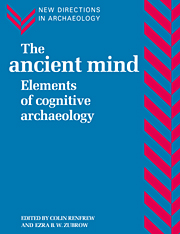Book contents
- Frontmatter
- Contents
- List of figures
- List of tables
- List of contributors
- Preface
- PART I INTRODUCTION
- PART II THE INTERDISCIPLINARY UNDERPINNING
- PART III APPROACHES TO CULT PRACTICE AND TRANSCENDENTAL BELIEF SYSTEMS
- PART IV PREHISTORIC CONCEPTIONS OF SPACE AND TIME
- PART V THE MATERIAL BASIS OF COGNITIVE INFERENCE: TECHNOLOGY
- PART VI THE MATERIAL BASIS OF COGNITIVE INFERENCE: WRITING SYSTEMS
- 16 Variation and change in symbol systems: case studies in Elamite cuneiform
- 17 Text and figure in ancient Mesopotamia: match and mismatch
- PART VII CONCLUSION
- Index
17 - Text and figure in ancient Mesopotamia: match and mismatch
Published online by Cambridge University Press: 03 December 2009
- Frontmatter
- Contents
- List of figures
- List of tables
- List of contributors
- Preface
- PART I INTRODUCTION
- PART II THE INTERDISCIPLINARY UNDERPINNING
- PART III APPROACHES TO CULT PRACTICE AND TRANSCENDENTAL BELIEF SYSTEMS
- PART IV PREHISTORIC CONCEPTIONS OF SPACE AND TIME
- PART V THE MATERIAL BASIS OF COGNITIVE INFERENCE: TECHNOLOGY
- PART VI THE MATERIAL BASIS OF COGNITIVE INFERENCE: WRITING SYSTEMS
- 16 Variation and change in symbol systems: case studies in Elamite cuneiform
- 17 Text and figure in ancient Mesopotamia: match and mismatch
- PART VII CONCLUSION
- Index
Summary
It is not necessary to stress that for the archaeologist in search of a society's thought processes, documents from the practice of religion or politics are of prime importance. With the durability of its written output on clay tablets, Mesopotamia offers an excellent opportunity to exploit this avenue, but it has not been followed in recent years. There has been a general reluctance on the part of archaeologists to engage with the written evidence, and those who read the texts have been equally reluctant to cross this barrier. With rare exceptions, when one side decides to make a foray into strange territory, it is just that - a foray, almost a commando raid, which takes some booty, wrenches it from its background and then proceeds to exploit it in their home territory according to their own priorities. This is bound to lead to mistakes: each side must take cognizance of the totality of the other side's data base, and understand how the tempting prizes actually belong in their own context. A totem pole, or a crucifix taken from an altar and nailed to a museum wall, cannot be understood without a knowledge of its provenance. Yet this is the way juicy snippets of information from the other side of the historical/archaeological divide have tended to be treated.
This is therefore, in part, a plea for increased crossfrontier awareness, accompanied by the proviso that one must match the ensemble of each body of data, not just selected items. Every tool at our disposal must be brought in.
- Type
- Chapter
- Information
- The Ancient MindElements of Cognitive Archaeology, pp. 176 - 184Publisher: Cambridge University PressPrint publication year: 1994
- 7
- Cited by



